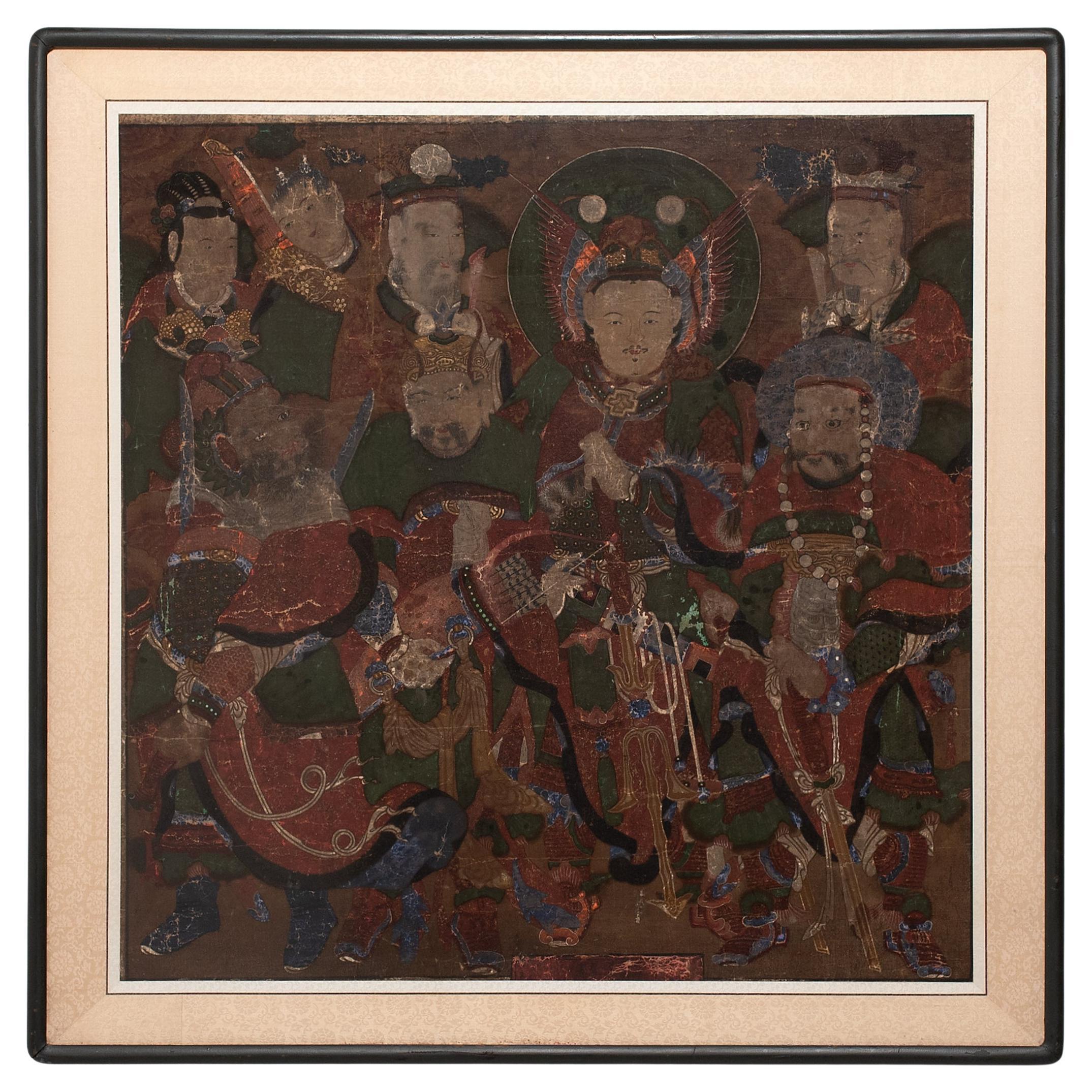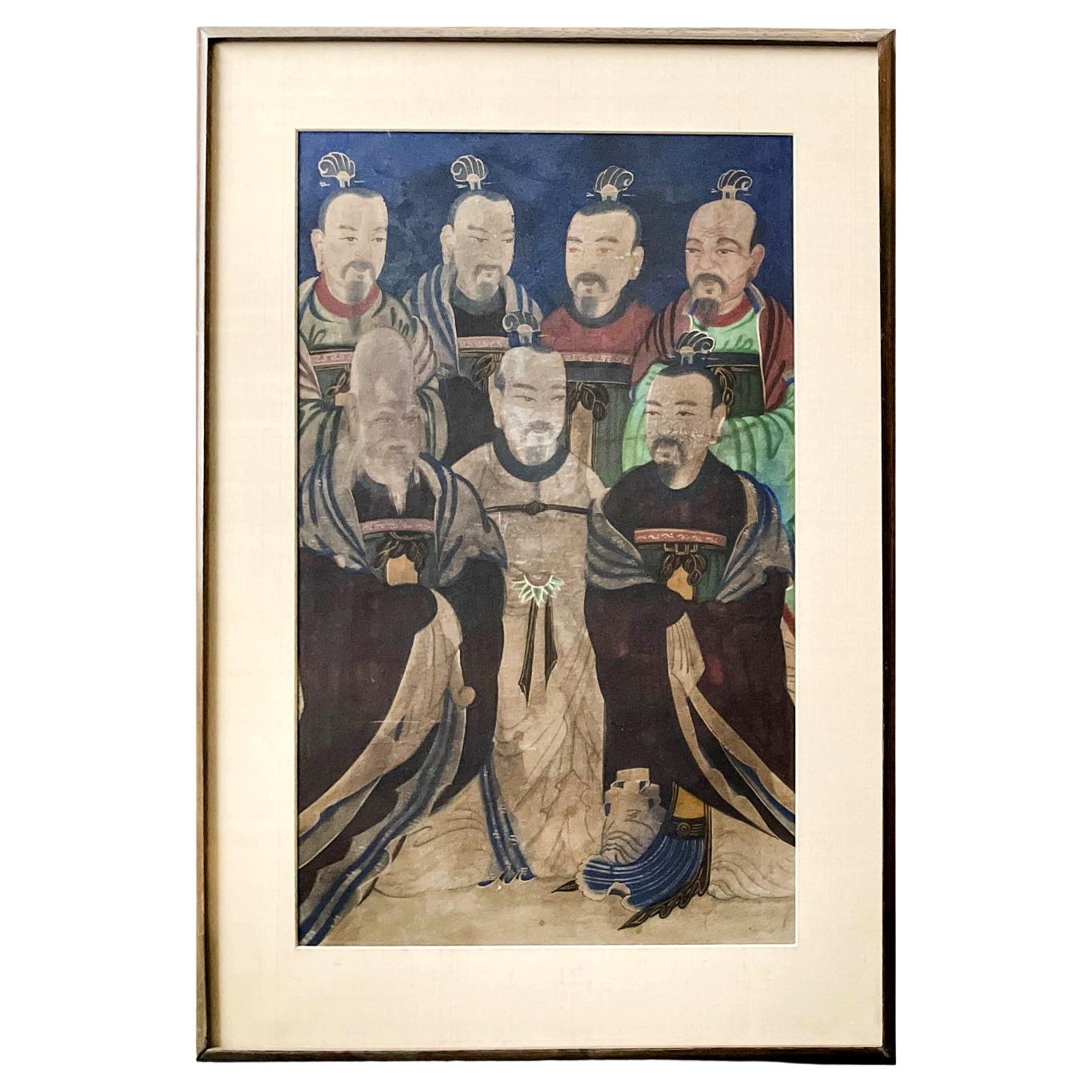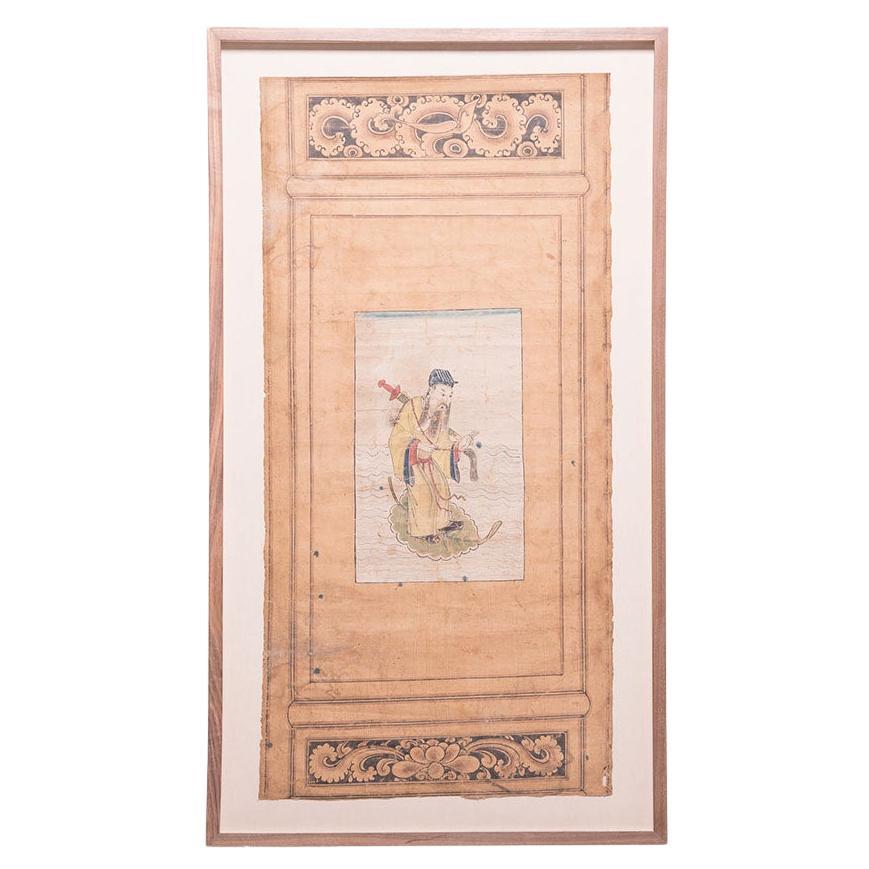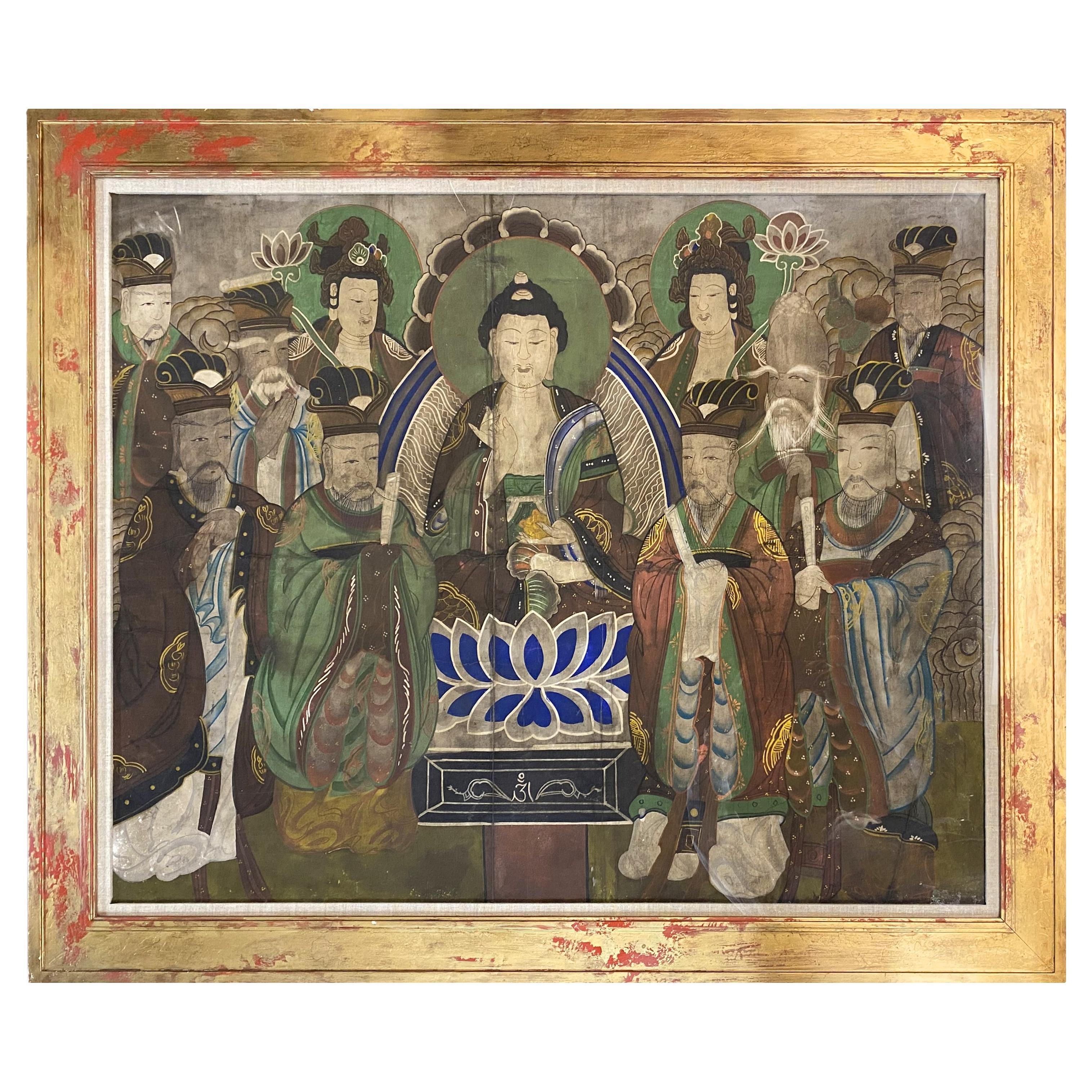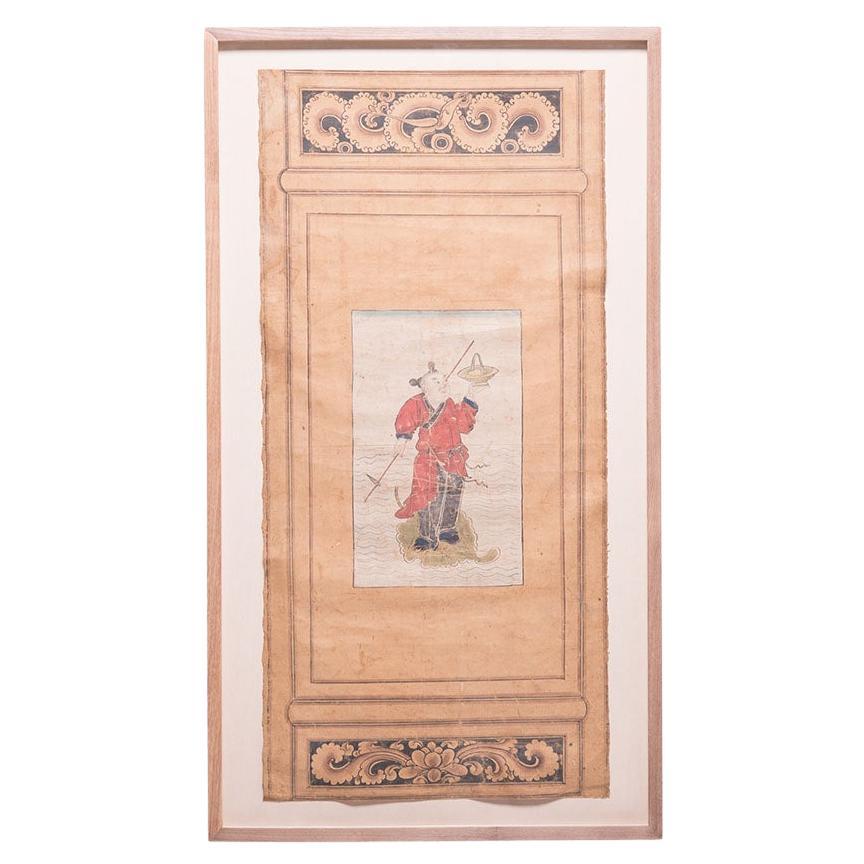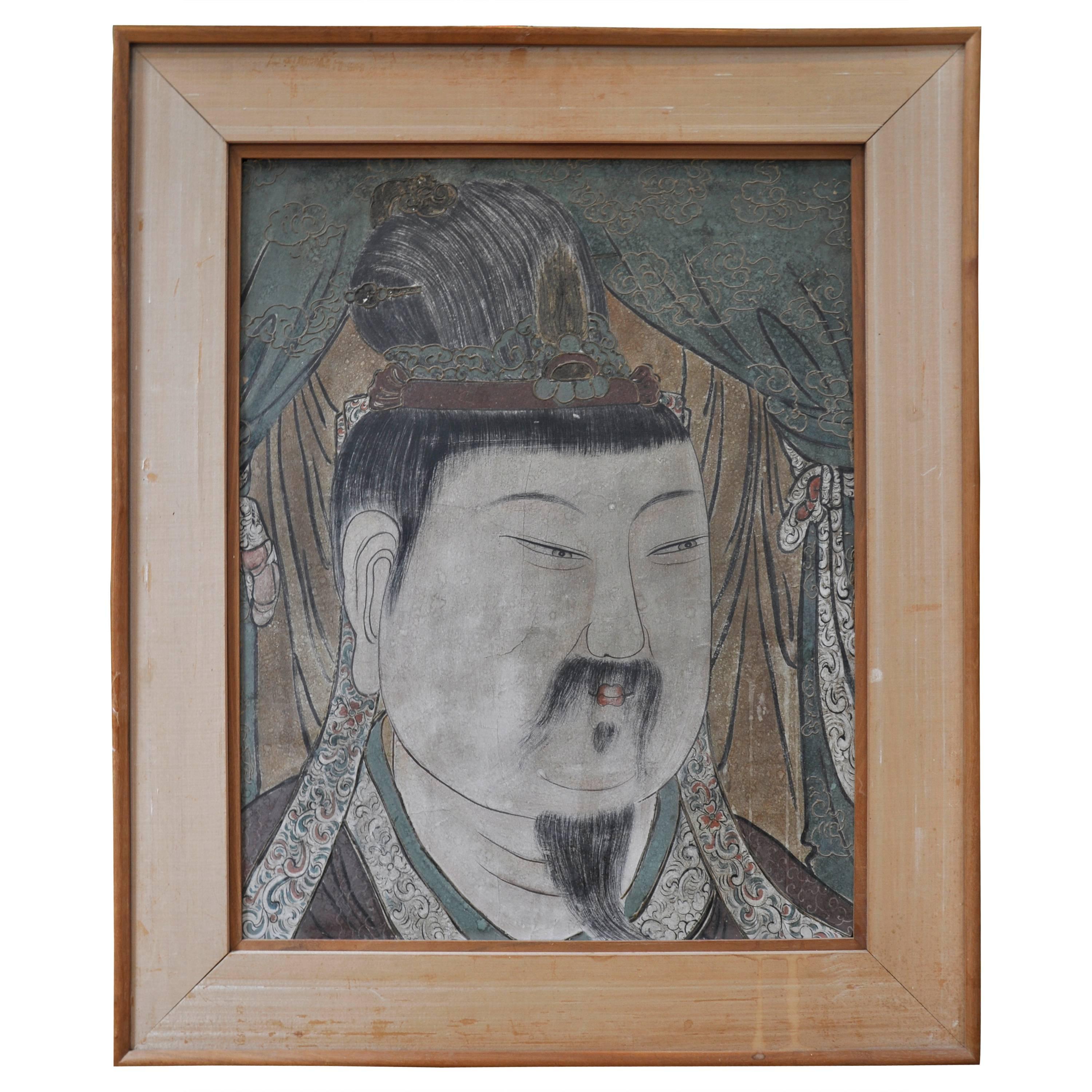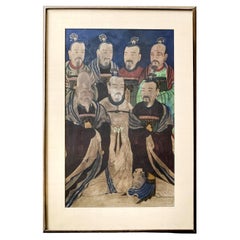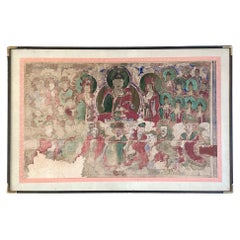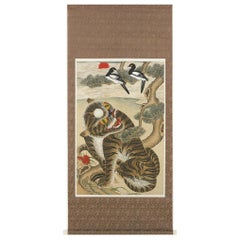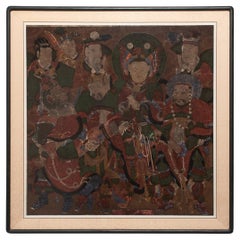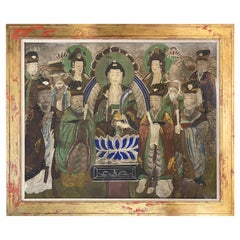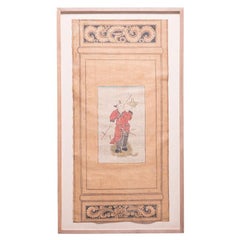Items Similar to Antique Korean Folk Painting of Mountain Spirit Joseon Dynasty
Want more images or videos?
Request additional images or videos from the seller
1 of 14
Antique Korean Folk Painting of Mountain Spirit Joseon Dynasty
$4,000
£3,035.11
€3,470.37
CA$5,586.92
A$6,211.89
CHF 3,243.51
MX$75,613.82
NOK 41,385.72
SEK 38,776.45
DKK 25,900.04
Shipping
Retrieving quote...The 1stDibs Promise:
Authenticity Guarantee,
Money-Back Guarantee,
24-Hour Cancellation
About the Item
An antique Korean folk painting of an old sage meditating among rocks under an ancient pine tree with a flying crane circa 19th century late Joseon period. The image was likely part of a larger scroll that depict of Mountain Spirit (Sansin in Korean). It is now presented with a beautiful brocade mat and mounted on a board. The frame has been removed therefore it needs new framing.
Mountain Spirit is a native shamanistic worship of the venerated mountain, where the deity deities descend from heaven to communicate with human. The prototype of the figure came from Chinese folklore The Northern Star, the old man of longevity. Always portraited as a wise old man with flowing robe, white bear and eyebrows, accompanied by a tiger, deer or crane in a mountainous landscape. The specific styling and his accoutrement may vary subtly, the influence of neo-Confucianism, Buddhism, Taoism and local Shamanism are always evident. The confluency created an interesting and unique imagery with a strong folky appeal. In this painting, the Sansin is seen seated in a lotus position, leaning against a green celadon pillow that appears to be made from ceramic (a reference to the hand rest or pillow made in Goryeo dynasty). He is holding a green Lingzi head on his right hand. The magic mushroom is a symbol of immortality. On his left, there is a green, bronze ewer, a prototype made during Goryeo Dynasties, that contains the ambrosia of longevity. On the mountainous rocks behind him, waterfalls appear to cascade down. The towering ancient pine and the flying crane on the composition in the background, are both symbols of longevity. The painting, it appears, used iconic symbols as well as colors to convey and highlight the intended ideas.
Despite dominated by Neo-Confucianism in Joseon dynasty, Buddhism and native shamanism still held onto their root of tradition strongly in the society. Buddhism could also be rather tolerant and even accepted the elements of the local shamanism. Often one could even see an altar or banner dedicated to Sansin in a Buddhist temple.
The work, ink and watercolor on paper, was most likely a large fragment of a hang scroll. The image size is 40.25"h x 23"w.
For another Sansin painting, see item 2000.8 in the collection of Asian Art Musuem in San Francisco. Illustrated on page 174-175 in the book "The Art of Korea Highlights from the collection of San Francisco's Asian Art Musuem".
To compare with a prototype Chinese Old man of longevity done in fine embroidery, see item LU945022650992 in our gallery collection
- Dimensions:Height: 49 in (124.46 cm)Width: 31 in (78.74 cm)Depth: 0.6 in (1.53 cm)
- Style:Folk Art (Of the Period)
- Materials and Techniques:
- Place of Origin:
- Period:
- Date of Manufacture:19th century
- Condition:Wear consistent with age and use. Good antique condition. Light fading and discoloration at places. A small historical repair under the right elbow as shown. Backing paper with small punctures. Needs new frame.
- Seller Location:Atlanta, GA
- Reference Number:1stDibs: LU945043441762
About the Seller
4.9
Platinum Seller
Premium sellers with a 4.7+ rating and 24-hour response times
Established in 2006
1stDibs seller since 2010
564 sales on 1stDibs
Typical response time: <1 hour
- ShippingRetrieving quote...Shipping from: Atlanta, GA
- Return Policy
Authenticity Guarantee
In the unlikely event there’s an issue with an item’s authenticity, contact us within 1 year for a full refund. DetailsMoney-Back Guarantee
If your item is not as described, is damaged in transit, or does not arrive, contact us within 7 days for a full refund. Details24-Hour Cancellation
You have a 24-hour grace period in which to reconsider your purchase, with no questions asked.Vetted Professional Sellers
Our world-class sellers must adhere to strict standards for service and quality, maintaining the integrity of our listings.Price-Match Guarantee
If you find that a seller listed the same item for a lower price elsewhere, we’ll match it.Trusted Global Delivery
Our best-in-class carrier network provides specialized shipping options worldwide, including custom delivery.More From This Seller
View AllFramed Korean Folk Shamanistic Painting of Seven Stars
Located in Atlanta, GA
A Korean folk painting watercolor on linen (silk) with a cloth mat and walnut wood frame. The work is in the shamanistic style and depicts the Tao...
Category
Early 20th Century Korean Folk Art Paintings and Screens
Materials
Textile
Korean Buddhist Temple Scroll Painting Sinjung T'aenghwa Joseon Dynasty
Located in Atlanta, GA
A large Korean Buddhist painting on silk framed in wood with an acrylic shadow box. The type of the painting is known in Korean as Sinjung T'aenghwa (Literally translated as Scroll-s...
Category
Antique 1880s Korean Other Paintings and Screens
Materials
Silk, Acrylic, Wood
Korean Jakhodo Minhwa Folk Scroll Painting
Located in Atlanta, GA
A Korean Folk Art painting mounted as a hanging scroll. The watercolor on paper was likely dated from 1930s-1940s. The work depicts a "Jakhodo" theme (...
Category
Vintage 1930s Korean Folk Art Paintings and Screens
Materials
Paper
Framed Korean Folk Painting of General Guan Gong
Located in Atlanta, GA
A Korean folk Shamanism watercolor on textile matted with woven brocade and presented in a wood frame with an oriental style metal hanging hardware. The painting was estimated to be from early 20th century circa 1910-1930s. It depicts Guan Yu (160-220AD), a legendary Chinese warrior and general from Eastern Han Dynasty. Long worshiped in China as a deity, across all three major religions, Guan Gong...
Category
Early 20th Century Korean Folk Art Paintings and Screens
Materials
Textile, Brocade
Japanese Silk Embroidery Tapestry Meiji Period
Located in Atlanta, GA
A spectacular Japanese embroidered silk panel beautifully presented in a gilt frame suspended in a lucite shadow box with gilt wood border. The silk picture is dated to 1890-1910s toward the end of Meiji Period, when Japanese started to participate international expose by presenting its best art and craft. Elaborate embroidered silk tapestry like this was very popular among westerners due to its superb craftmanship and also exotic subject matter that was often derived from classic Japanese folklore, mythology and various motifs. The tapestry on offer is such an example. It depicts an old couple...
Category
Antique 1890s Japanese Japonisme Textiles
Materials
Fabric, Silk, Lucite
Korean Folding Chaekgeori Painted Scholar Floor Screen
Located in Atlanta, GA
A six-panel painted folding floor screen from Korea circa early 20th century. This type of screen is called Chaekgeori (books and things) which is quite unique to Korea. It became popular at the end of 18th century favored and encouraged by King Jeongjo (1752-1800) as a political tool to promote social conservatism such as the traditional Confucianism value, especially considered important in a time when waves of new ideology influx came to Korea. Initially commissioned for the royal court, they became increasingly popular with the scholars of noble and affluent households and were used widely in their halls and studies. Early screens were painted with trompe-l’oeil bookcases displaying books and arrays of collectibles. Later, the bookcases were eliminated to focus on the assemblage of neatly stacked books and objects of scholarly pursue. On this screen, the six panels were neatly presented and framed in woven brocade borders. Among the stacked volumes, one can find many fine porcelain vases with flowers, potted orchids, pen holders with brush pens and scroll paintings, incense burner, ink stone, teapot, fan with ink painting, vessels of fruits, exotic plants such as lotus, plumeria and even a pair of glasses. It feels like a pleasant visual measure hunting for the viewers. Several words in Chinese found their way into the picture as well, including filial (xiao), longevity (shou) and luck (fu).
The painting was done in a meticulous way with no details overlooked and also with a rather western still-life dimensional perspective. In a rather unusual maximal but also minimalistic way, the screen exudes a historical charm with a folky flair but appears modern at the same time.
Each panel is 17.5"w by 70.2"h.
For general information on the subject see reference: Chaekgeori the Power and Pleasure of Possessions in Korean Painted Screens...
Category
20th Century Korean Folk Art Paintings and Screens
Materials
Brocade, Silk, Wood, Paper
You May Also Like
Korean Buddhist Guardian Mural Taenghwa Painting, c. 1800
Located in Chicago, IL
Evolving from the Korean tradition of tomb mural painting came the Buddhist practice of “taenghwa,” or hanging-painting, a form of religious painting that included hanging scrolls, framed paintings and wall murals. Influenced by Chinese and Central Asian Buddhist art...
Category
Antique Early 19th Century Korean Paintings and Screens
Materials
Cotton, Paint
Chinese Mythical Immortal Screen Painting, c. 1850
Located in Chicago, IL
Since the 12th century, people in China have used folding screens and doors to partition and decorate their homes - the vivid scenes backing the screens added life and color to a roo...
Category
Antique Mid-19th Century Chinese Paintings
Materials
Fabric, Paint
18th/19th Century Korean Buddhist T’aenghwa Painted Scroll or Banner in Frame
Located in Milford, NH
A fine Korean Buddhist T’aenghwa scroll painting, similar to the Tibetan Thangka paintings. The Korean name taenghwa is very similar to the Tibetan word thangka and the period of pop...
Category
Antique 18th Century Korean Paintings
Materials
Canvas
Chinese Mythical Immortal Screen Painting, c. 1850
Located in Chicago, IL
Since the 12th century, people in China have used folding screens and doors to partition and decorate their homes - the vivid scenes backing the screens added life and color to a room. This 19th-century painting is delicately brushed of gouache and ink on fabric and was originally part of a set of eight backing a wooden screen in northern China.
The figure depicted is one of the mythical Eight Immortals of Taoism. Said to have attained immortality through their studies of the natural world, each of the Eight Immortals represents a different condition in life and together they impart a blessing of prosperity and longevity. Depicted here is immortal Lan Caihe, the patron saint of florists and gardeners. Standing atop a lotus leaf in open water, they hold a gardening hoe in one hand and a basket for flowers...
Category
Antique Mid-19th Century Chinese Paintings
Materials
Fabric, Paint
19th Century Chinese Painting
Located in Dallas, TX
Imperial portrait on paper.
Category
Antique 18th Century Chinese Other Paintings and Screens
Materials
Paint
Framed Chinese Paintings of Northern Asian Nomadic Ethnic Group Livings
Located in Greenwich, CT
Framed Pair of Chinese Paintings of Northern Asian Nomadic Ethnic Group Livings
Depicted Northern Asian nomadic people daily life and living...
Category
Antique 19th Century Chinese Paintings and Screens
Materials
Silk
More Ways To Browse
Wood Spirit
Painting Antique Pine Furniture
19th Century Ink Wells
Large Antique Fragment
Robe Man
Hand Painted Banner
Folk Art Tiger
Wood Chinese Temple
Asian Screens Green
Antique Deer Mounts
Bronze Ewer
Altar Frame
Korean Folk Art
Antique Bronze Ewers
Flying Cranes
Asian Painted Scrolls
Mushroom Seat
Antique Chinese Brocade
